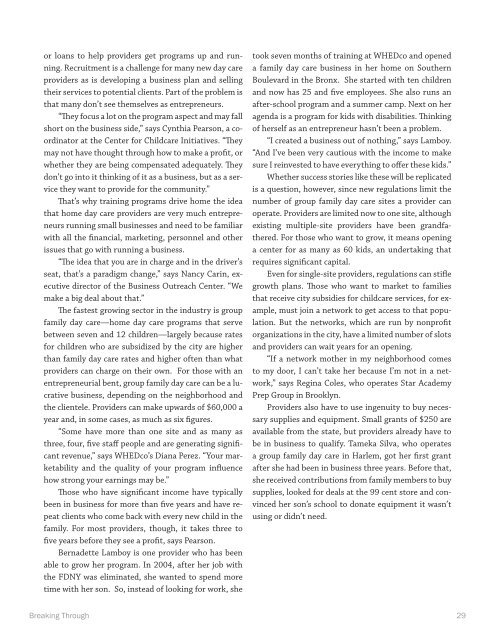BREAKING THROUGH
YWkgl
YWkgl
Create successful ePaper yourself
Turn your PDF publications into a flip-book with our unique Google optimized e-Paper software.
or loans to help providers get programs up and running.<br />
Recruitment is a challenge for many new day care<br />
providers as is developing a business plan and selling<br />
their services to potential clients. Part of the problem is<br />
that many don’t see themselves as entrepreneurs.<br />
“They focus a lot on the program aspect and may fall<br />
short on the business side,” says Cynthia Pearson, a coordinator<br />
at the Center for Childcare Initiatives. “They<br />
may not have thought through how to make a profit, or<br />
whether they are being compensated adequately. They<br />
don’t go into it thinking of it as a business, but as a service<br />
they want to provide for the community.”<br />
That’s why training programs drive home the idea<br />
that home day care providers are very much entrepreneurs<br />
running small businesses and need to be familiar<br />
with all the financial, marketing, personnel and other<br />
issues that go with running a business.<br />
“The idea that you are in charge and in the driver’s<br />
seat, that’s a paradigm change,” says Nancy Carin, executive<br />
director of the Business Outreach Center. “We<br />
make a big deal about that.”<br />
The fastest growing sector in the industry is group<br />
family day care—home day care programs that serve<br />
between seven and 12 children—largely because rates<br />
for children who are subsidized by the city are higher<br />
than family day care rates and higher often than what<br />
providers can charge on their own. For those with an<br />
entrepreneurial bent, group family day care can be a lucrative<br />
business, depending on the neighborhood and<br />
the clientele. Providers can make upwards of $60,000 a<br />
year and, in some cases, as much as six figures.<br />
“Some have more than one site and as many as<br />
three, four, five staff people and are generating significant<br />
revenue,” says WHEDco’s Diana Perez. “Your marketability<br />
and the quality of your program influence<br />
how strong your earnings may be.”<br />
Those who have significant income have typically<br />
been in business for more than five years and have repeat<br />
clients who come back with every new child in the<br />
family. For most providers, though, it takes three to<br />
five years before they see a profit, says Pearson.<br />
Bernadette Lamboy is one provider who has been<br />
able to grow her program. In 2004, after her job with<br />
the FDNY was eliminated, she wanted to spend more<br />
time with her son. So, instead of looking for work, she<br />
took seven months of training at WHEDco and opened<br />
a family day care business in her home on Southern<br />
Boulevard in the Bronx. She started with ten children<br />
and now has 25 and five employees. She also runs an<br />
after-school program and a summer camp. Next on her<br />
agenda is a program for kids with disabilities. Thinking<br />
of herself as an entrepreneur hasn’t been a problem.<br />
“I created a business out of nothing,” says Lamboy.<br />
“And I’ve been very cautious with the income to make<br />
sure I reinvested to have everything to offer these kids.”<br />
Whether success stories like these will be replicated<br />
is a question, however, since new regulations limit the<br />
number of group family day care sites a provider can<br />
operate. Providers are limited now to one site, although<br />
existing multiple-site providers have been grandfathered.<br />
For those who want to grow, it means opening<br />
a center for as many as 60 kids, an undertaking that<br />
requires significant capital.<br />
Even for single-site providers, regulations can stifle<br />
growth plans. Those who want to market to families<br />
that receive city subsidies for childcare services, for example,<br />
must join a network to get access to that population.<br />
But the networks, which are run by nonprofit<br />
organizations in the city, have a limited number of slots<br />
and providers can wait years for an opening.<br />
“If a network mother in my neighborhood comes<br />
to my door, I can’t take her because I’m not in a network,”<br />
says Regina Coles, who operates Star Academy<br />
Prep Group in Brooklyn.<br />
Providers also have to use ingenuity to buy necessary<br />
supplies and equipment. Small grants of $250 are<br />
available from the state, but providers already have to<br />
be in business to qualify. Tameka Silva, who operates<br />
a group family day care in Harlem, got her first grant<br />
after she had been in business three years. Before that,<br />
she received contributions from family members to buy<br />
supplies, looked for deals at the 99 cent store and convinced<br />
her son’s school to donate equipment it wasn’t<br />
using or didn’t need.<br />
Breaking Through 29


